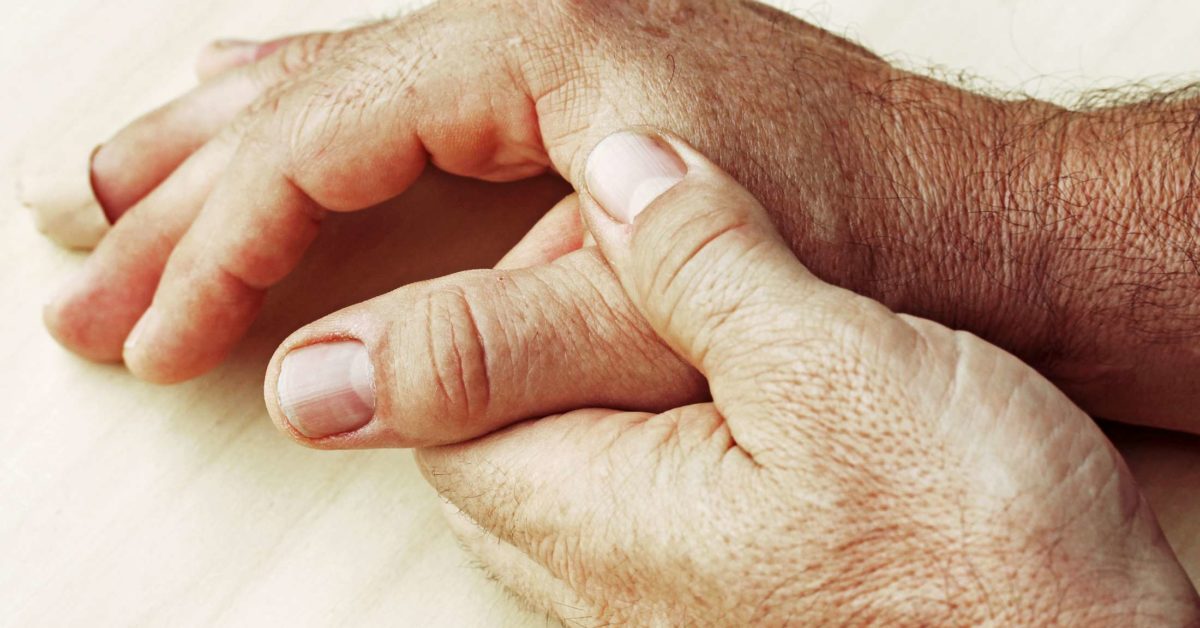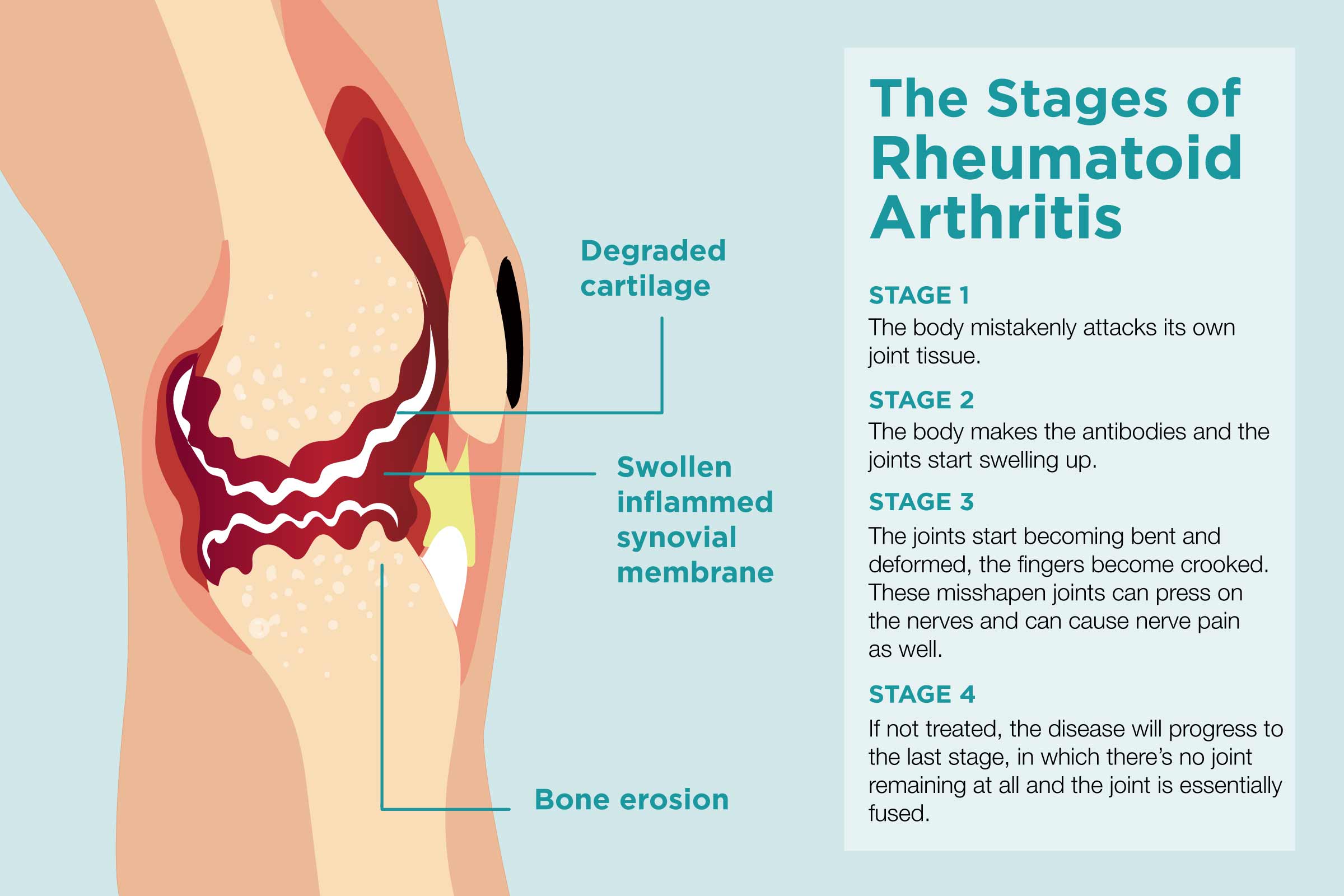What Are The Signs And Symptoms Of Ra
With RA, there are times when symptoms get worse, known as flares, and times when symptoms get better, known as remission.
Signs and symptoms of RA include:
- Pain or aching in more than one joint
- Stiffness in more than one joint
- Tenderness and swelling in more than one joint
- The same symptoms on both sides of the body
- Weight loss
Exercise Joint Pain And Rheumatoid Arthritis
When your joints are stiff and painful, exercise might be the last thing on your mind. Yet with RA, exercising regularly is one of the best things you can do.
- People who work out live longer, with or without rheumatoid arthritis.
- Regular exercise can cut down on RA pain.
- Your bones will be stronger. Thinning of the bones can be a problem with rheumatoid arthritis, especially if you need to take steroids.
- Stronger muscles help you move better.
- Your mood and energy level will benefit.
Complementary And Alternative Remedies For Treating Rheumatoid Arthritis
In addition to conventional treatments medication, physical therapy, and, if necessary, surgery some lifestyle changes and home remedies may be beneficial. Alternative therapies that fall outside of conventional Western medicine may provide additional relief. It’s also important to pay attention to your mental health and to work to reduce the stress of living with RA. Relaxation techniques, visualization exercises, group counseling, and psychotherapy are worth considering.
Some complementary or alternative therapies, such as homeopathy, hydrotherapy, or cryotherapy, might help relieve RA symptoms, though the clinical evidence supporting these methods has been inconclusive. You might want to explore therapies such as acupuncture, tai chi, and yoga. While some people have found these approaches helpful, the research overall hasn’t found clear, definitive benefits.
You should always check with your medical provider before trying any complementary or alternative therapies.
You’ll also want to check with your doctor before using home remedies to relieve the pain and inflammation from a flare-up. At-home treatments that may help soothe pain and stiffness include hot or cold treatments, over-the-counter topical pain relievers, and braces or splints that support the joints.
Read Also: How To Relieve Arthritis Pain In Thumb
How Is Rheumatoid Arthritis Treated
The goals of rheumatoid arthritis treatment are to:
- Control a patient’s signs and symptoms.
- Prevent joint damage.
- Maintain the patients quality of life and ability to function.
Joint damage generally occurs within the first two years of diagnosis, so it is important to diagnose and treat rheumatoid arthritis in the window of opportunity to prevent long-term consequences.
Treatments for rheumatoid arthritis include medications, rest, exercise, physical therapy/occupational therapy, and surgery to correct damage to the joint.
The type of treatment will depend on several factors, including the person’s age, overall health, medical history, and the severity of the arthritis.
Types Of Rheumatoid Arthritis

Due to a lack of knowledge about the cause of RA, it is difficult to classify the disease completely.
As different patients exhibit varying progression rates and symptoms, the disease is currently classified into seropositive or seronegative RA. This basic and primary classification can help determine treatment options.
Also Check: Can You Exercise With Arthritis
How Can Rheumatoid Arthritis Be Treated
Its hard to avoid rheumatoid arthritis if its genetic. However, you can lower your chances of disease or rapid progression by quitting smoking, avoiding toxic environments, eating a healthy diet , and avoiding obesity, Dr. Lam states.
Rheumatoid arthritis is typically treated using medications, physical therapy, and surgery.
Dr. Lam also says, treatments involves immunosuppressants to slow the disease progression, disease modifying anti-rheumatic drugs called DMARDs, anti-inflammatories, in certain cases steroids, and physical therapy. These medications all have their own side effects such as suppressing the immune system but the benefits tend to outweigh the risks over all. In severe cases, the patient may need surgery or joint replacement.
What Are The Risk Factors For Ra
Researchers have studied a number of genetic and environmental factors to determine if they change persons risk of developing RA.
Characteristics that increase risk
- Age. RA can begin at any age, but the likelihood increases with age. The onset of RA is highest among adults in their sixties.
- Sex. New cases of RA are typically two-to-three times higher in women than men.
- Genetics/inherited traits. People born with specific genes are more likely to develop RA. These genes, called HLA class II genotypes, can also make your arthritis worse. The risk of RA may be highest when people with these genes are exposed to environmental factors like smoking or when a person is obese.
- Smoking. Multiple studies show that cigarette smoking increases a persons risk of developing RA and can make the disease worse.
- History of live births. Women who have never given birth may be at greater risk of developing RA.
- Early Life Exposures. Some early life exposures may increase risk of developing RA in adulthood. For example, one study found that children whose mothers smoked had double the risk of developing RA as adults. Children of lower income parents are at increased risk of developing RA as adults.
- Obesity. Being obese can increase the risk of developing RA. Studies examining the role of obesity also found that the more overweight a person was, the higher his or her risk of developing RA became.
Characteristics that can decrease risk
Recommended Reading: What Kind Of Doctor Treats Arthritis Of The Spine
When To See A Doctor
The sooner you treat RA, the better. Early diagnosis leads to timely treatment, which keeps the condition from getting worse and resulting in more serious complications.
It is recommended to schedule a visit to your doctor if you experience:
- Prolonged swelling and soreness in your joints for weeks
- Stiffness in the joints on waking up
- How do I know if my joint pain is the result of rheumatoid arthritis and not something else?
- Could RA be prevented, or is it genetic?
- What medicines would work best for me, and what are the side effects?
- What are the risks and benefits of joint surgery?
- Does RA reduce my life expectancy?
- How long have you had your symptoms?
- Have your symptoms evolved over time or remained the same?
- Is there anything that aggravates or improves your condition?
- Which joints are affected?
- Is your condition interfering with your daily activities?
What Is Treat To Target
T2T is a term that experts use to describe treating a disease while keeping very specific goals in mind. In other words, its a methodical way to make decisions regarding treatment. It involves several steps:
Choosing a target, or goal, for treatment
Making a change to treatment if the target is not met
T2T starts with shared decision-making, meaning you and your rheumatologist will work together to come up with a plan. For example, if you were recently diagnosed with RA, and its time to start treatment, you and your healthcare provider would have a discussion based on the points above. This would include your goal for treatment, what medication to start, and how and when to decide if its working.
Also Check: How To Treat Arthritis In Hands
Rheumatoid Arthritis And Diet Considerations
When it comes to the connection between diet and rheumatoid arthritis improvement, much of the scientific evidence is inconclusive, and the clinical studies haven’t been very large. But some people claim that certain dietary modifications have helped relieve their RA symptoms. It’s important to check with your doctor before you make any significant changes to your dietary habits.
Nutrition ReviewsAnnals of the Rheumatic DiseasesFrontiers in Nutrition
Use Hot And Cold Therapy
Heat and cold treatments can help relieve arthritis pain and inflammation.
- Heat treatments can include taking a long, warm shower or bath in the morning to help ease stiffness and using an electric blanket or moist heating pad to reduce discomfort overnight.
- Cold treatments can help relieve joint pain, swelling, and inflammation. Wrap a gel ice pack or a bag of frozen vegetables in a towel and apply it to painful joints for quick relief. Never apply ice directly to the skin.
- Capsaicin, which comes from chili peppers, is a component of some topical ointments and creams that you can buy over the counter. These products provide warmth that can soothe joint pain.
Recommended Reading: Can Rheumatoid Arthritis Cause Swollen Lymph Nodes
Heres Why The Disease Progresses What To Expect And How To Stop It
Rheumatoid arthritis is a chronic condition for which there is no cure. But even though the disease is progressive, newer disease-modifying drugs may actually be able to slow or even halt it getting worse. We have many effective treatments for RA that help control the symptoms of joint pain and stiffness, but also prevent progression of the disease and the development of permanent damage, says Lindsay Lally, MD, a rheumatologist at Hospital for Special Surgery in New York City.
Early treatment for RA is key, because whatever joint damage has already occurred cant be reversed. Find out how to recognize the symptoms at each stage of RA, and what can be done to treat it.
What Are The Goals Of Treating Rheumatoid Arthritis

The most important goal of treating rheumatoid arthritis is to reduce joint pain and swelling and to maintain and/or improve joint function.
The long-term goal of treatment is to slow or stop the disease process, particularly joint damage, which can be seen on X-rays. Once joint inflammation is controlled, pain will be reduced.
Normal joint and joint affected by rheumatoid arthritis
In the past, many doctors did not believe that drugs for rheumatoid arthritis changed the likelihood of eventual disability from the disease. Therefore, drugs with the fewest side effects were prescribed to decrease pain. Stronger drugs were avoided because of doctors’ concerns about dangerous side effects.
Now, however, doctors know that early treatment with certain drugs can improve the long-term outcome for most rheumatoid arthritis patients. Numerous drugs that have been shown to be effective are being used soon after the patient is diagnosed. Combinations of drugs are proving to be more effective than a single drug therapy and, in recent studies, have been found to be just as safe as single-drug treatment.
Read Also: What Is The Best Cream For Rheumatoid Arthritis
What Are Rheumatoid Arthritis Causes And Risk Factors
The cause of rheumatoid arthritis is unknown. Even though infectious agents such as viruses, bacteria, and fungi have long been suspected, none has been proven as the cause. The cause of rheumatoid arthritis is a very active area of worldwide research. It is believed that the tendency to develop rheumatoid arthritis may be genetically inherited . Certain genes have been identified that increase the risk for rheumatoid arthritis. It is also suspected that certain infections or factors in the environment might trigger the activation of the immune system in susceptible individuals. This misdirected immune system then attacks the body’s own tissues. This leads to inflammation in the joints and sometimes in various organs of the body, such as the lungs or eyes.
It is not known what triggers the onset of rheumatoid arthritis. Regardless of the exact trigger, the result is an immune system that is geared up to promote inflammation in the joints and occasionally other tissues of the body. Immune cells, called lymphocytes, are activated and chemical messengers are expressed in the inflamed areas.
Gut bacteria, smoking, and gum disease
Environmental factors also seem to play some role in causing rheumatoid arthritis. For example, scientists have reported that smoking tobacco, exposure to silica minerals, and chronic periodontal disease all increase the risk of developing rheumatoid arthritis.
Understand that many forms of joint disease mimic rheumatoid arthritis.
How Is Ra Diagnosed
RA is diagnosed by reviewing symptoms, conducting a physical examination, and doing X-rays and lab tests. Its best to diagnose RA earlywithin 6 months of the onset of symptomsso that people with the disease can begin treatment to slow or stop disease progression . Diagnosis and effective treatments, particularly treatment to suppress or control inflammation, can help reduce the damaging effects of RA.
Read Also: Does Rheumatoid Arthritis Affect Your Toes
Creams Gels And Lotions
Topical creams, gels, and lotions can be rubbed directly onto the skin to help ease painful joints. As the skin absorbs the ingredients, you may experience temporary relief of minor joint pain.
Topical ointments can also come in spray form or patches. Products that contain capsaicin, salicylates, camphor, or menthol are standard for treating arthritis.
Theres limited current research on using these treatments for RA. Still, a 2017 study found that a gel containing menthol, benzocaine, and procaine hydrochloride resulted in temporary pain relief in people with RA.
Arthritis medications in the form of creams may also be effective.
According to a 2015 study, etoricoxib cream, piroxicam cream, and diclofenac cream reduced pain and swelling for RA, with etoricoxib cream giving the most relief.
What Is The Goal Of Treatment
As mentioned above, the goal is to diagnose and treat RA early to prevent as much damage as possible. Thankfully, many effective treatments are available. The most commonly used medications are called disease-modifying antirheumatic drugs , which work by targeting inflammation.
Many RA medications have been approved in the last decade, and now there are several treatment options. With so many options and so many factors to consider , knowing where to start can seem daunting. Thats why experts from the American College of Rheumatology have come up with treatment guidelines based on years of research. As part of those guidelines, a treat to target approach is recommended.
Read Also: How Do You Detect Rheumatoid Arthritis
What Are The Factors I Should Consider When Choosing A Rheumatoid Arthritis Treatment
The American College of Rheumatology has published guidelines for RA treatment that can help you and your rheumatologist come up with a treatment plan together. Know that your treatment choice will depend on things like how long youve had symptoms, the severity of your symptoms, and how many joints are affected. For example, early RA will be approached differently than established RA.
Also, rheumatologists have different scoring systems to determine if your RA is mild, moderate, or severe. The scores take into account how many joints are painful and swollen, markers of inflammation in your bloodwork, and how you are feeling overall.
The following is a summary of what the guidelines suggest:
-
Treatment should begin with a DMARD, usually methotrexate.
-
If methotrexate is not enough, another DMARD, TNF inhibitor, or other biologic should be used. Methotrexate can be continued or not, although many experts prefer that the people they are treating continue using it if possible.
-
TNF inhibitors and other biologics are preferred over tofacitinib, except in people with established RA.
-
If a TNF inhibitor does not work well enough, switching classes is recommended. This strategy has been shown to be more effective than trying another TNF inhibitor.
-
NSAIDs and glucocorticoids should be used for a short time when needed for flares.
Ra Progression Isnt Inevitable
Thanks to the newer treatments available and more on the horizon RA doesnt have to mean a life of eventual disability or even limited mobility. Its not an inevitable thing nowadays, says Dr. Bhatt. People can have a normal life.
But patients do have to be sure to follow their treatment plan and doctors recommendations. Routine follow-up with a rheumatologist who performs joint exams, follows levels of systemic inflammation in the blood and can assess function is the best way to ensure RA is being controlled and is not progressing, Dr. Lally says.
Don’t Miss: How Does Rheumatoid Arthritis Feel
Natural Treatments For Rheumatoid Arthritis
There are some complementary medicine treatments that might help with your RA. Itâs a good idea to talk it over with your doctor first. Youâll still need to take your medicine and keep up with the other parts of your treatment plan.
Heat and cold. Ice packs can reduce joint swelling and inflammation. Put a cold compress or ice pack on the joint. Use the ice packs for 15 minutes at a time, with 30-minute breaks in between.
Heat compresses relax muscles and stimulate blood flow. Wrap a warm towel or pad around the area that hurts. Or try a warm bath or shower.
Relaxation. Try progressive muscle relaxation. This is when you tense or tighten one muscle group and then relax it. Take deep breaths as you do. Start with the muscles of your feet. Move slowly up your body, ending with the muscles of your face.
Sleep. A lack of shut-eye can make your joints hurt. Go to bed and get up at the same time each day. Try to get some exercise every day. Avoid nicotine, caffeine, and alcohol. And don’t forget to “unplug” your bedroom: Turn off TVs, computers, and phones.
Capsaicin. It’s an ingredient in hot peppers. Studies show that it can ease pain when you rub your joints with cream that’s got some in it. You may feel more pain at first, but it usually eases up.
Acupuncture. Studies show that acupuncture curbs pain, may lower the need for painkillers, and is good for helping affected joints stay flexible.
Possible Complications Of Rheumatoid Arthritis

In general, patients with RA have frequent comorbidities, that is, other chronic disorders that complicate their overall health.
- Patients with RA have reduced healthspan and lifespan.
- RA increases the risks of cardiovascular diseases, such as hypertension, diabetes, and elevated cholesterol, even beyond the usual factors.
- Patients with RA also have about twice the risk of lymphoproliferative diseases, such as leukemia and lymphoma.
- Some of the medications used for RA treatment may result in adverse effects and can increase the risk of infection or kidney problems, thus requiring close monitoring.
Read Also: Does Rheumatoid Arthritis Affect Your Skin